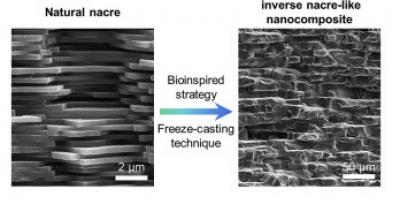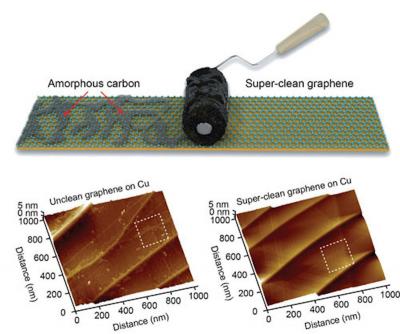Epoxy-graphene nanocomposites can be improved with nacre-inspired design
 eft: Natural nacre. Right: Inverse nacre-like epoxy-graphene layered nanocomposites. (Image taken from Nanowerk)
eft: Natural nacre. Right: Inverse nacre-like epoxy-graphene layered nanocomposites. (Image taken from Nanowerk)An activated carbon-coated lint roller can yield super-clean graphene
In order for CVD graphene to be used in its intended application, it needs to be transferred from the growth substrate to a target substrate a challenging but extremely important process step. Typically the transfer is done by spin-coating a supporting polymer layer and then chemically dissolving away the copper to release the graphene film from the substrate. The transferred graphene produced in this way is prone to contamination from the chemical agents used to remove the growth substrate as well as defective amorphous carbon generated during the high-temperature CVD growth. It also frequently leads to a substantial amount of polymer particle residue on the graphene generated during the transfer process. A third source of contamination could be airborne particles that are adsorbed onto the graphene surface.
 Top: Schematic of the activated carbon-coated lint roller for cleaning the graphene surface. Bottom left: AFM image of unclean graphene on Cu foil. Bottom right: AFM image of superclean graphene on Cu foil. Image taken from Nanowerk
Top: Schematic of the activated carbon-coated lint roller for cleaning the graphene surface. Bottom left: AFM image of unclean graphene on Cu foil. Bottom right: AFM image of superclean graphene on Cu foil. Image taken from Nanowerk
Researchers from Peking University and Tsinghua University in China and University of Manchester in the UK have recently demonstrated that the amorphous carbon contaminants on CVD-produced graphene, which could greatly degrade its properties, can be removed by an activated carbon-coated lint roller, relying on the strong interactions between the amorphous carbon and activated carbon.
GrapheneCA provides graphene for major commercial construction project in Mexico
GrapheneCA has reported that it is the sole provider for all of the graphene being used in a major commercial construction project that makes use of the miracle material currently underway in Mexico.
 The Centro de Convenciones Siglo XXI is being built 200 kilometers away from Cancún
The Centro de Convenciones Siglo XXI is being built 200 kilometers away from Cancún
In a statement, the privately-owned graphene supplier and manufacturer, said the new convention center, Centro de Convenciones Siglo XXI, which is being built 200 kilometers away from Cancún, relies on concrete enhanced by GrapheneCA’s 99.7% carbon pure graphene in its entirety.
Verditek raises over $730,000 for solar cell commercialization
Verditek, developer of lightweight solar panels along with Paragraf, a Cambridge-based graphene technology developer, announced that it has raised GBP 600,000 (around USD 739,500/EUR 676,400) in a share placing to speed up its growth plans, replenish working capital and fund a silicon/graphene solar project.
The company said it will use the raised funds to speed up its growth plans as it moves to commercialization, provide working capital for its Italian solar factory, which can currently produce 20 MW of modules per year, and cover its 50% share of the joint development programme with Paragraf, under which the two are working on a silicon/graphene integrated solar cell.
UW-Milwaukee graphene monoxide battery startup receives a second commercialization grant
Two physicists at the University of Wisconsin-Milwaukee have been awarded a grant of over a $1 million from the U.S. Department of Energy to develop lithium-ion battery parts made from a unique, patented material called graphene monoxide. Their material is said to dramatically boost the energy storage capacity of li-ion batteries.
Dr. Carol Hirschmugl and Dr. Marija Gajdardziska-Josifovska, founders of UWM-incubated startup SafeLi (now renamed: Conovate), received a Small Business Technology Transfer (STTR) grant to further commercialize the material they created in their physics laboratories.
Directa Plus to buy 51% of commercial partner Setcar and raise new funds
 Directa Plus recently reported a broadly unchanged interim loss, despite a 56% year-on-year rise in revenue, and said that it plans to acquire a majority stake in a Romanian waste management and decontamination services business for EUR4.1 million.
Directa Plus recently reported a broadly unchanged interim loss, despite a 56% year-on-year rise in revenue, and said that it plans to acquire a majority stake in a Romanian waste management and decontamination services business for EUR4.1 million.
Directa Plus also said it will raise up to GBP8.2 million to fund the Romanian stake acquisition.
University of Manchester and Khalifa University collaboration uses GO to take salts out of water
A partnership between The University of Manchester and Khalifa University of Science and Technology in Abu Dhabi has yielded graphene-based membranes aimed at to taking salts out of water.
The most popular method for water desalination currently is a process called reverse osmosis, which requires large quantities of water to be forced through a membrane to remove the salts in the water. This method is particularly useful when there is a high salt content, however more efficient methods are required for bodies of water that have a lower salt content, known as brackish water. The team of researchers has developed new ion-selective membranes incorporating graphene oxide, for use in electromembrane desalination processes such as electrodialysis and membrane capacitive deionization.